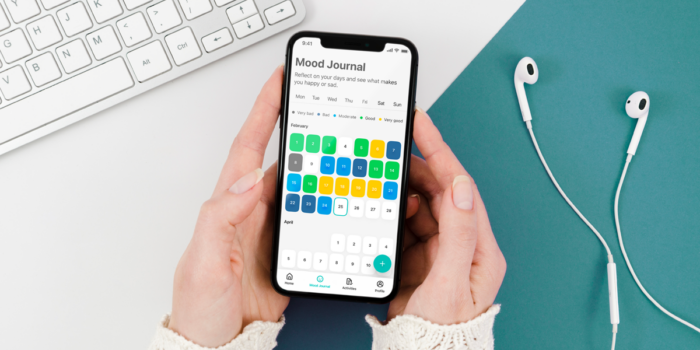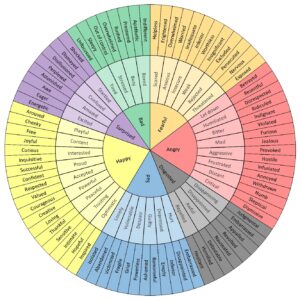
How often do you say, “I feel good” or “I feel bad?” Probably pretty often, but are you aware of what you actually feel? Dissecting your emotions can be tricky, but it’s crucial in order to understand what’s making you feel the way you do. This is where mood journaling comes in handy.
Mood Journaling for Exploring the Emotion Wheel
Human emotions are a complicated concept, and understanding them can be notoriously difficult. For this reason, psychotherapists have developed a tool that can assist in figuring out your true feelings.

An emotion wheel consists of 3 main parts:
- Core emotions. The inner circle describes 6 primary human emotions: anger, disgust, sadness, happiness, fear, surprise, moodiness, and sadness.
- Middle circle. The middle circle expands on the primary emotions – if you’re mad, do you feel humiliated, hostile, or aggressive?
- Outer circle. The outer circle expands on the middle circle to better evaluate the emotion. If your core emotion is anger, and you feel humiliated, is it disrespect or ridicule that you’re experiencing?
The emotion wheel helps us dig into the true reasons behind our feelings – we become more aware and understanding of the situation that happened to us and our response to it.
The Benefits of Mood Journaling
Consistently tracking your moods and delving into understanding the reasons behind them has various benefits, especially concerning mental health.
Being in touch with yourself can help you discover triggers and possible reactions to situations.
Mood journaling helps you get to know yourself as a person – like you would know a friend. Over time, dedicating time to unravel your emotional reactions will allow you to notice that you don’t just feel bad or sad – there’s usually more to each feeling.
Increased awareness
Writing about your emotions and thoughts can help increase self-awareness and understanding of the patterns and triggers.
By letting your thoughts flow on paper or in an app, you can begin to notice what makes you feel and behave in a certain way.
In the long run, you’ll be able to manage your emotional reactions the moment you’re experiencing them, so no more meltdowns or snapping at people when you least expect it.
Emotional regulation
Mood journaling can also provide a healthy medium to blow off steam after an intense situation. Not only that, but it can also help you express your emotions in a stable, healthy environment.
Sometimes, it’s difficult to explain why you’re feeling a certain way, but writing down what you’re feeling and why can provide a sense of relief, validation, and release.
This way, you can manage your emotional response better.
Progress tracking
Keeping a mood journal provides you with an opportunity to grow and track how much you’re progressing in your self-improvement journey.
Consistent mood journaling will reveal your emotional patterns and the impact of certain life situations. With this data, you can decide to make changes to your lifestyle, environment, or social connections.
It’s a great feeling to see that, over the course of a few months, you don’t feel sad or angry as much, and your happiness has increased.
Better communication
Writing down your feelings, emotions, and experiences can significantly improve your communication with others.
Discovering how you actually feel makes it easier to explain your emotional well-being and health concerns to your peers, family members, and even healthcare providers.
Less stress and more positivity
Studies have found that mood journaling can have a calming effect on your mind – exploring your emotions through the act of journaling can soothe anxiety and reduce stress.
Moreover, journaling also allows you to reflect and reframe your thinking. After the initial response, you might be able to perceive certain feelings in a different light.
Over time, this can lead to a better overall mindset and positive outlook.
While mood journaling can seem like a tedious task, the benefits are undeniable. The more you get into it, the better your understanding of yourself becomes.





